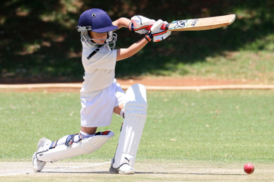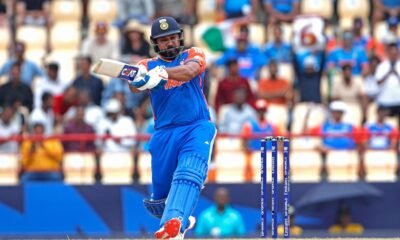Cricket
Becoming a Pro in Playing Cricket | The Biggest Tips and Tricks for Beginners
[ad_1]
Jack Sneddon |

Cricket is growing in popularity as millions of people around the world build interest in the sport. It is a wildly popular sport, globally considered to come second only to soccer as the most followed sport. While football, baseball, and basketball are still dominant in the United States, evidence shows that the popularity of cricket is gaining traction. Are you a beginner with an interest in the sport and with a dream of one day making it as a professional? While joining a cricket academy is your safest bet to learn crucial skills, you can still make it on your own through practice. Here are some of the most notable cricket tips to help you get started.
- Learn to Stand Sideways
One of the most notable tips you can get to improve your cricket skills is to practice standing sideways when batting. The right stance when batting is a strong foundation for your shots. It allows you to get into the right stat to optimize effort before facing a bowler’s delivery. Experts also advise that getting in the right stance helps with your confidence and precision. Establishing a proper stance during cricket batting is akin to constructing a solid base for assertive shot production. It puts you at ease when facing the bowler’s delivery. Your stance should make you comfortable enough to be relaxed but at the same time able to develop balance with power and control so that you can show authority and confidence holding the bat on strike. And remember, you can create time to practice your skills by getting a college essay writing service to help with your academic projects.
One of the most important things here is your feet placement. This helps to give more balance to your stance and also helps to keep the height low when facing the ball. The wider the feet go in width, the more the center of gravity drops, and this makes you feel much more balanced. Try not to go too wide, and make sure it is at a level that suits you; otherwise, you may feel uncomfortable. Two factors to consider at this point are that, on a cricket pitch where the ball doesn’t bounce as much, a lower center of gravity is required, so you may need to go slightly wider. However, for a bouncy pitch or tennis ball batting, it is better to go straight and upright, like a military stance.
Make sure to face the bowler while standing with your feet at shoulder-width distance. Keep your body bent at the hips, ensuring that your back remains straight. Position yourself with the bat ready, directing your dominant shoulder towards the bowler and maintaining eye contact with the ball. Remember to keep your shoulders up and at eye level. For players, stand on the right side of the stump; for left-handed players, position yourself on the left side of the stump.
Keep the non-dominant hand at the top and the dominant hand at the bottom of your grip on the wooden willow. It is the upper hand that will give you the direction to deliver your shots. It is the bottle hand where the power comes through and behind your shots. Hold your bat tight and loose at the same time. All the fingers must be wrapped around the handle of the bat completely so that when your bat comes for a shot, it will have better control. Of course, having a rubber grip over your bat’s handle is a must. Just stick to a good bat grip brand and develop a confident wrist to work with your bat.
Again, it is very important to grip the bat tightly and firmly. For a right-handed player, the left hand should be placed at the end of the bat facing towards the bowler. You should place your right hand on top of your left hand while holding it with two fingers and a thumb. The thumb and first finger must be well-positioned and firmly gripped. The reverse is true for left-handed batsmen. Be sure that your hands are close together so that holding the paddle of the bat feels comfortable in your hand.
- Watch the Distance Between the Bat and the Stump
Use your bat to draw a line from the middle of the popping crease towards your side of the pitch. This will help you position your wicket correctly when you are batting. Ensure the line is parallel to the middle stump while making it. It is known as the “guard” line. If you are playing indoors, you can use tape to mark out where your guard lines should be. Also, tap the guard line to let the bowler know you are ready to bat. Never dig your foot into the crease. Stand as straight as you can so you don’t slouch with the bat.
- Develop Swing Backward Momentum
When you flex your knee, not only do you enhance stability but also add flexibility to your body stance. This particular posture allows you to adapt to different deliveries and ensure proper shot play— all while getting the timing and power right. Consider acquiring lightweight, flexible batting pads to help with comfort as you step onto the pitch; this small adjustment can greatly impact your game.
Always have your lead leg forward when the ball is coming, and you have to hit it. When you hit the ball, swing your bat back in line for speed. Your bat, when lifted, should point straight to the air, up to your back shoulder. When the ball is low, hit the ball; when the ball is up high, blackboard the ball. Have your bat line up when you lift to hit the ball, with your forearm right next to your shoulders. Keep practicing, and create time to master your sports and academic skills by getting help from an essay writing service.
This article offers a few insights for beginners on how to play cricket. Always keep your eyes on the ball and swing the bat downward. If you follow the ball till it is pitched, you can figure out where you need to be to hit the ball. Think what shot you can play as soon as the ball comes to you. If the ball is at a good length, you can play a drive and take a big shot, but if the ball is too high or too low, play a defensive shot. This is one of the most important cricket batting techniques for beginners to remember and follow. After the ball bounces, push your bat down to hit. Move your lead leg forward and point your elbow towards the bowler. Follow the bat as much as you can to hit the ball. This is the most common cricket batting technique and is called straight drive.
[ad_2]


















